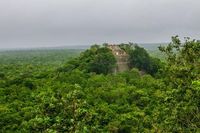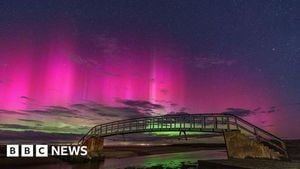In a transformative week for southeastern Mexico and its neighbors, three landmark developments have unfolded—each promising to reshape the region’s future. From the expansion of the Deep Sea Port of Progreso to the creation of a massive trinational forest reserve and the continuing impact of the Maya Train, these projects reflect a new era of connectivity, conservation, and economic ambition across the Yucatán Peninsula and beyond.
On August 18, 2025, the governments of Mexico, Guatemala, and Belize signed an historic agreement to establish the Biocultural Corridor of the Great Mayan Forest (CBGSM). According to Wanderlust Magazine, this colossal trinational reserve will span 5.7 million hectares, making it the second largest tropical rainforest protected area in the Americas. The corridor unites 27 protected areas in Guatemala, 11 in Belize, and 12 in Mexico—including renowned sites such as Mirador-Río Azul National Park, Aguas Turbias Protected Natural Area, and the Calakmul Biosphere Reserve.
Home to around 7,000 species—including 200 listed as at risk and 50 identified as priority species—the Maya Forest is a living tapestry of biodiversity. It shelters jaguars, tapirs, spider monkeys, and quetzals, and also holds deep cultural significance as the cradle of ancient Mayan civilization. The joint declaration, as reported by Wanderlust Magazine, "recognizes the living cultures of the region – the indigenous Mayan and Afro-descendant communities – as guardians of nature."
Belizean Prime Minister John Antonio Briceño emphasized the spirit of unity driving the project, stating, "We are not only protecting an ecosystem, but also honouring the legacy of the civilisation that once flourished in these territories. Mexico, Guatemala, and Belize demonstrate once again that our political borders do not divide, but rather unite efforts to preserve one of the last lungs of the planet and the living heritage of the Mayan people."
The three countries have agreed to share information, technology, and training in areas like integrated fire management, combating illegal logging, and preventing deforestation. They will also coordinate the sustainable use of timber and non-timber forest resources, aiming to benefit local communities while preserving the environment. Notably, the corridor encompasses a mosaic of ecosystems—lowland, mid- and highland rainforests, and the unique Petenes mangroves—across the Yucatán Peninsula.
This conservation push comes at a time when the region is also experiencing rapid infrastructure growth. The Mexican portion of the Yucatán Peninsula is now connected by the Maya Train, a project completed in December 2024. The railway links major destinations such as Palenque, Chichén Itzá, and Cancún, providing a new artery for tourism and commerce. However, as reported by Wanderlust Magazine and AP News, the Maya Train has drawn criticism from Indigenous communities and environmental groups like Greenpeace, who have voiced concerns about its impact on sensitive habitats.
During the press conference announcing the biocultural corridor, Guatemalan President Bernardo Arévalo addressed the future of the Maya Train, confirming that consultations are underway to potentially connect the rail line to Guatemala and Belize. Importantly, he assured, "the line will not pass through any protected area." This commitment seeks to balance the drive for regional integration with the imperative to safeguard irreplaceable ecosystems.
Meanwhile, on August 16, 2025, the National Institute of Agricultural Development (Indaabin) in Mexico determined the value of 1.9 hectares of land in the X-Hazil ejido, located in Felipe Carrillo Puerto, Quintana Roo, for incorporation into the Maya Train project. According to TYT Newsroom, the compensation for the expropriated land was set at 1.2 million pesos, following a decree published in the Official Gazette of the Federation (DOF). The process was overseen by the National Agrarian Registry and the Secretariat of Agrarian, Territorial, and Urban Development (Sedatu), with a clear stipulation: if the land is used for purposes other than those specified, or if the public utility requirement is not met within five years, the National Ejido Development Fund Trust can reclaim the property.
This careful legal framework reflects the broader challenge of development in the region—balancing economic opportunity with social and environmental responsibility. The Maya Train itself is both a symbol of progress and a lightning rod for debate, illustrating the complexities inherent in large-scale projects that touch on heritage, livelihoods, and the natural world.
Perhaps nowhere is this balancing act more visible than in the bustling port city of Progreso. As of August 18, 2025, the long-anticipated expansion of the Deep Sea Port of Progreso has entered its active phase. According to Yucatán Magazine, the arrival of the Fernando de Magallanes—a 138.5-meter, 30,000-horsepower dredging vessel that crossed the Atlantic from Europe—marks a pivotal moment. The vessel will remove sediment and deepen the port, enabling it to handle much larger ships and greater cargo volumes.
The port expansion is backed by a historic investment of 7.9 billion pesos (around $400 million USD), funded through a partnership of federal, state, and private sectors. The project will add 80 hectares to the facility, increasing its total operational area to 116 hectares. The navigation channel will be widened and deepened, allowing vessels carrying up to 100,000 tons—more than double the current capacity—to dock at Progreso. The port currently processes about 54,000 twenty-foot equivalent units (TEUs) annually, with 22 vessel arrivals per month.
Yucatán Governor Joaquín Díaz Mena, who toured the advanced dredging vessel, described the project as a "turning point for the state’s economic and commercial development." The expansion is a cornerstone of the Plan Renacimiento Maya (Maya Renaissance Plan), a comprehensive strategy that aims to boost economic development, education, and employment while enhancing regional connectivity.
One of the most ambitious elements of the plan is the proposed connection of the Maya Train to Puerto Progreso as a cargo rail line. Announced by President Claudia Sheinbaum, this strategic logistics corridor—managed by Mexico’s Defense Ministry—carries an estimated cost of 35 billion pesos. The goal is to position Yucatán as a key logistics hub linking Mexico to the United States and global markets. Major exports from Progreso include textiles, electronics, agricultural products, seafood, and honey.
Beyond the port, the Maya Renaissance Plan encompasses wellness initiatives, a new metropolitan ring road, and clean energy projects valued at 2.4 billion pesos. In the coming months, the Fernando de Magallanes will also conduct dredging operations at other Yucatecan ports, including Sisal, El Cuyo, and Celestún, further enhancing the region’s maritime infrastructure.
As these interconnected projects unfold, they offer both promise and complexity. The creation of the Biocultural Corridor of the Great Mayan Forest signals a renewed commitment to conservation and cultural heritage, even as the Maya Train and port expansion drive economic modernization. The challenge ahead lies in ensuring that these ambitions reinforce rather than undermine each other—honoring the past, protecting the environment, and building a sustainable future for generations to come.




